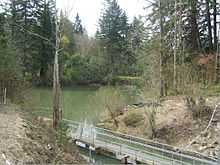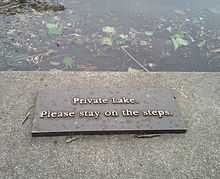Oswego Lake
| Oswego Lake | |
|---|---|
 Lakewood Bay (connected to the main lake in 1928) | |
| Location | Lake Oswego, Clackamas County, Oregon |
| Coordinates | 45°24′34″N 122°41′47″W / 45.40944°N 122.69639°WCoordinates: 45°24′34″N 122°41′47″W / 45.40944°N 122.69639°W |
| Type | Kolk depression/Reservoir |
| Primary inflows | Tualatin River, Springbrook Creek |
| Primary outflows | Willamette River (via Oswego Creek) |
| Catchment area | 6.6 sq mi (17 km2)[1] |
| Basin countries | United States |
| Max. length | 2.5 mi (4.0 km) |
| Max. width | 0.3 mi (0.48 km) |
| Surface area | 420 acres (1.7 km2)[2] |
| Average depth | 26 ft (7.9 m)[1] |
| Max. depth | 55 ft (17 m)[1] |
| Water volume | 10,055 acre·ft (12,403,000 m3)[1] |
| Residence time | 2 months[1] |
| Shore length1 | 11.95 mi (19.23 km)[2] |
| Surface elevation | 99 ft (30 m)[1] |
| Islands | Jantzen Island |
| Settlements | Lake Oswego |
| 1 Shore length is not a well-defined measure. | |
Oswego Lake is a lake in Clackamas County, Oregon that is completely surrounded by the city of Lake Oswego. Though the lake is naturally occurring (a former channel of the Tualatin River), it has been significantly altered because of the concrete dam that has increased its size to 395 acres (1.60 km2). Officially, the United States Geological Survey records the official name as Lake Oswego and classifies it as a reservoir (due to its artificially increased size).[3] To distinguish it from the city, however, the lake is usually called Oswego Lake.[4]
Geologic history
The lake is a former channel of the Tualatin River, carved in basalt to the Willamette River. Eventually, the river changed course and abandoned the Oswego route.[1][2]
About 13,000 to 15,000 years ago, the ice dam that contained Glacial Lake Missoula ruptured, resulting in the Missoula Floods, which backed the Columbia River up the Willamette River. The flooding created an underwater vortex called a kolk, which scoured out and enlarged the old Oswego channel, creating a natural lake.[5] The rocks and boulders were flung by the kolk up to a mile away to present-day Durham and Tualatin, where they were quarried for many years before the site was converted to the Bridgeport Village shopping center.[1][6]
Early human habitation
The lake was known to the native Clackamas Indians as Waluga ("wild swan"), for the birds they hunted there. With the arrival of European settlers in the mid-19th century, the lake was called Sucker Lake for a type of fish that was abundant in its waters.[7] In 1847, Albert Alonzo Durham built a sawmill on on Sucker Creek, the lake's outlet to the Willamette River. In 1850, he made the first Donation Land Claim in the area, which he named Oswego after Oswego, New York.[8]
Iron industry

Lake expansion

A series of wooden dams had been built at the outlet to Sucker Creek beginning in 1860 to provide water power; but since winter floods would wash out these dams within a few years, in 1921 a concrete dam was built, which not only provided a more reliable power source, but also allowed the lake level to be precisely controlled. The level was allowed to rise several feet to cover the unsightly stumps left over from logging and create a more visually appealing shoreline.[13]
With the name Sucker Lake considered unappealing to potential residents, the community decided to rename the lake. While "Lake Tualatin" was considered, in 1913 the United States Board on Geographic Names officially renamed it Oswego Lake.[14] In 1961, the USGS officially changed the name to "Lake Oswego," though the old name is usually used to avoid confusion with the name of the city.[3][4]
In 1928, a marshy area known as the Duck Pond adjacent to the lake was flooded, and a canal dug to it to connect to the main lake to create Lakewood Bay, which allowed more shoreline homes to be built next to the newly completed Pacific Highway (now part of Oregon Route 43).[15]
Land development

In 1924, Paul Murphy developed the Oswego Lake Country Club to promote Oswego as a place to "live where you play."[8] The Paul Murphy Company replaced Ladd's company as developer of Oregon Iron and Steel's property in 1940, and the following year, Oregon Iron and Steel created the Lake Oswego Corporation, which still owns the lake as a private corporation of lakefront property owners.[14] In 1960, shortly before ending its existence, Oregon Iron & Steel was disbanding deeded the powerhouse and dams to the corporation.[14]
With the relative scarcity of building easements, lakefront property remains prestigious, and a number of architecturally significant homes have been built along its shores, including the Carl C. Jantzen Estate, a Tudor-style estate on the National Register of Historic Places, built on an island on the lake's north shore by the founder of the Jantzen swimwear company in 1930. In addition, the lakeshore features homes by noted Portland architects such as Richard Sundeleaf and Van Evera Bailey.[16]
Ownership and access

Despite a decades-old status quo in which the Lake Oswego Corporation maintains that it owns the lake and has the authority to restrict access to it, state and local law enforcement have recently indicated that they consider the lake to be public and that they will not pursue charges against anyone for using it.[17] As of 2012, local law enforcement was on the record saying the water is public property and that it was more likely to charge the corporation's security patrols with unlawful arrest than to cite swimmers or boaters for enjoying the water.[17]
Nonetheless, the corporation has successfully cultivated an air of authority to control the waters, posting "no trespassing" signs and issuing permits to select individuals who overcome various administrative hurdles.[17] The corporation also seeks to regulate boat and operator licensing, water safety, and water quality,[18] but those regulations may not be actually binding.[17] With most land around the lake privately owned, and following a unanimous vote by the Lake Oswego City Council to bar entry to the lake from several lakefront parks,[19] few people have been able to test the authority of the corporation to enforce those regulations.[17]
The ability of the corporation to restrict access to the water has been questioned on numerous occasions.[20][21] According to recent independent assessments of the legal situation, including a 2005 Oregon Attorney General opinion regarding the public's right to use navigable waterways in Oregon,[22] the waters are publicly owned, though the ground beneath the lake is owned by the shareholders of the corporation, including 690 lakefront property owners and another 515 families who belong to one of 20 waterfront easement associations.[17][23][24][25]
The corporation argues that the federal Water Resources Development Act of 1976 specifically classified the lake as non-navigable; therefore, the Attorney General opinion—which states that waterways over private land are only public if they are "navigable-for-public-use"—does not apply.[22][25][26] The corporation also asserts that the lake is an artificially-expanded power reservoir and not a natural body of water.[20][27]
In May 2012, a federal lawsuit was filed against the city of Lake Oswego to prevent it from limiting public access to the lake.[28] The case was dismissed from federal court in October, with the judge indicating that the state of Oregon, due to its presumed ownership interest, should be able to weigh in on the case.[29] The plaintiffs refiled in state court in November 2012,[30] and in early 2014, the judge ruled that the city had the right to block access.[31]
Lake health

See also
Notes
- ↑ 1.0 1.1 1.2 1.3 1.4 1.5 1.6 1.7 Johnson, Daniel M. (June 1985). Atlas of Oregon Lakes. Oregon State University Press. p. 114. ISBN 0-87071-343-4.
- ↑ 2.0 2.1 2.2 "Lake Oswego". Atlas of Oregon Lakes. Portland State University. Retrieved April 2, 2012.
- ↑ 3.0 3.1 "Feature Detail Report for: Lake Oswego". United States Geological Survey. Retrieved February 6, 2012.
- ↑ 4.0 4.1 Schouten, Hank (May 29, 1984). ""Lake Oswego" lochs up first place in name game". The Oregonian. p. 1MS.
- ↑ Stephens, Patia (Winter 2001). "Sedimental Journey". The Montanan. University of Montana. Retrieved 2008-04-02.
- ↑ "Oswego (Sucker) Lake, Lake Oswego, Oregon Waymark". Waymarking.com. Retrieved 2008-04-02.
- ↑ Fulton, p. 15
- ↑ 8.0 8.1 8.2 "A Brief History". City of Lake Oswego. Retrieved 2008-04-02.
- ↑ 9.0 9.1 Kuo, Susanna Campbell. "A Brief History of the Oregon Iron Industry". Oswego Heritage Council. Retrieved 2008-04-02.
- ↑ Fulton, p. 33
- ↑ 11.0 11.1 Corning, Howard McKinley (2004). Willamette Landings (3rd ed.). Portland, Oregon: Oregon Historical Society. p. 195. ISBN 0-87595-042-6.
- ↑ Fulton, p. 33
- ↑ Fulton, p. 80
- ↑ 14.0 14.1 14.2 "Eight Myths Concerning Lake Oswego". Oswego Heritage Council. Retrieved 2008-04-02.
- ↑ Fulton, p. 83
- ↑ Goetze, Janet (February 2, 2008). "Big new homes lack grace of the past, says architect". The Oregonian. Retrieved 2008-04-02.
- ↑ 17.0 17.1 17.2 17.3 17.4 17.5 Cizmar, Martin (2012-03-07). "Lake Affront". Willamette Week (Portland, Oregon). Retrieved 2012-03-09.
- ↑ "Other Links: Oswego Lake". City of Lake Oswego. Retrieved 2008-04-02.
- ↑ Bailey Jr., Everton (April 3, 2012). "Lake Oswego approves new park rules banning lake entry from city-owned property". The Oregonian. Retrieved May 14, 2012.
- ↑ 20.0 20.1 Amick, Steven (October 1, 1982). "One voice raised against Oswego Lake deregulation". The Oregonian. p. B1.
- ↑ "Fishing at Oswego". The Oregonian. August 15, 1946. p. B1.
- ↑ 22.0 22.1 Myers, Hardy (April 21, 2005). "Oregon Attorney General Opinion No. 8281". Oregon Attorney General. Retrieved March 12, 2012.
- ↑ 23.0 23.1 Jaquiss, Nigel (2005-04-27). "Lake O-be-gone". Willamette Week. Retrieved 2008-04-02.
- ↑ Murphey, Kara Hansen (January 12, 2012). "Oswego Lake access is focus of group". Lake Oswego Review. Retrieved April 20, 2013.
- ↑ 25.0 25.1 Bailey Jr., Everton (February 12, 2012). "Lake Oswego residents, critics spar over public access to 415-acre lake". The Oregonian. Retrieved February 12, 2012.
- ↑ Murphey, Kara Hansen (February 23, 2012). "Oswego Lake: It is private — or is it?". Portland Tribune. Retrieved April 20, 2013.
- ↑ Thomas, Doug (October 20, 2011). "Oswego Lake portrayed wrongly". Lake Oswego Review. Retrieved April 20, 2013.
- ↑ Cizmar, Martin (May 24, 2012). "Oswego Lake Access Issue Heads to Federal Court". Willamette Week. Retrieved May 24, 2012.
- ↑ Harbarger, Molly (October 12, 2012). "Oswego Lake access suit plaintiffs plan to file in state court after dismissed by federal court". The Oregonian. Retrieved December 18, 2012.
- ↑ Cizmar, Martin (May 24, 2012). "Oswego Lake Lawsuit Now in State Court". Willamette Week. Retrieved December 18, 2012.
- ↑ Runquist, Justin (January 10, 2014). "Judge sides with city in lawsuit over public access to Oswego Lake". The Oregonian. Retrieved January 16, 2014.
- ↑ Tims, Dana (October 31, 2006). "Drawdown under way to lower Oswego Lake". The Oregonian.
- ↑ Newell, Cliff (July 29, 2010). "Sewer project will make Oswego Lake disappear – briefly". The Oregonian. Retrieved April 20, 2013.
- ↑ Newell, Cliff (June 2, 2011). "LOIS is flush with success". Lake Oswego Review. Retrieved April 20, 2013.
References
Fulton, Ann (2002). Iron, Wood & Water: An Illustrated History of Lake Oswego. San Antonio, Texas: Historical Publishing Network and the Oswego Heritage Council. ISBN 1-893619-26-5.